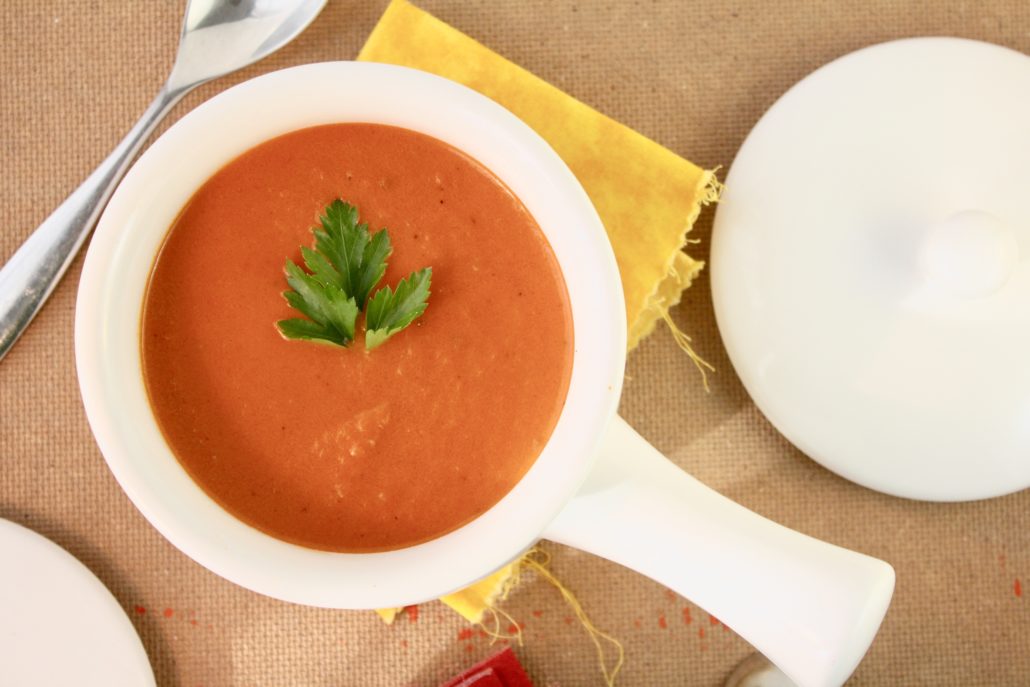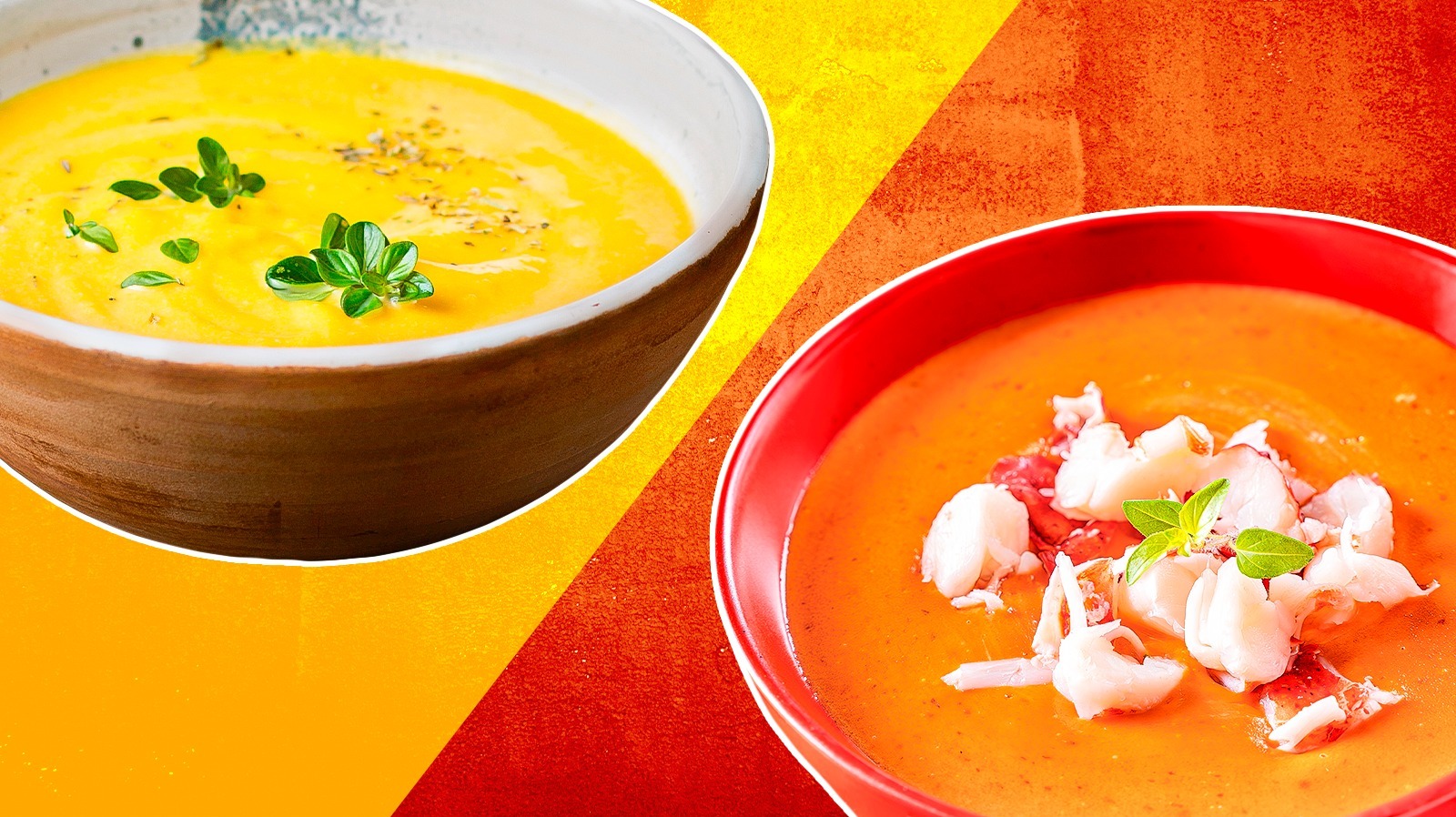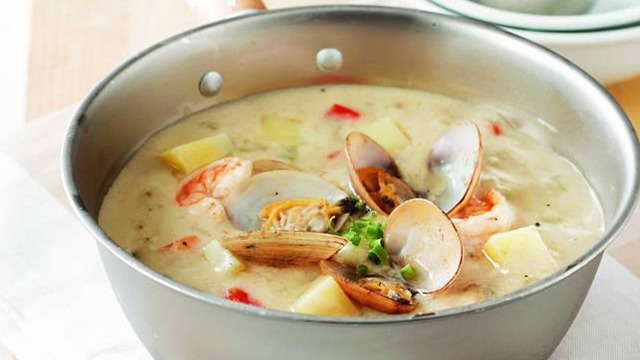Chowder: A Hearty And Creamy Soup Option

Chowder is a beloved soup option known for its hearty and creamy texture. It is a comforting dish that is perfect for those chilly winter days. Chowders are typically made with a creamy base, often thickened with potatoes and enriched with cream. What sets chowder apart is its chunky texture, usually packed with ingredients like seafood, vegetables, and herbs. From the classic New England clam chowder to corn chowder, there are endless variations to explore. Whether you prefer a seafood or vegetable chowder, you can’t go wrong with this delicious and satisfying soup option.
Chowder: Definition And Origins
Chowder is a popular type of soup known for its hearty and creamy texture. The word “chowder” originated from the French word “chaudière,” which means a cooking pot or cauldron. It was initially a humble dish made by fishermen using their fresh catch, potatoes, onions, and milk or cream. Chowder originated in coastal regions like New England in the United States and Maritime provinces in Canada, where seafood was abundant. Over time, chowder recipes have evolved to include different variations such as clam chowder, corn chowder, and seafood chowder, showcasing the unique flavors of each region. So, whether you’re a seafood lover or prefer a vegetarian version, chowder offers a comforting and satisfying soup experience.
Chowder Ingredients And Preparation Methods
Chowder is a rich and flavorful soup that can be made with a variety of ingredients. While the base typically includes potatoes, onion, and milk or cream, the star ingredient can vary depending on personal preference or regional traditions. Popular variations include clam chowder, corn chowder, and seafood chowder. The preparation method involves simmering the ingredients together until the potatoes are tender and the flavors have melded. Some recipes call for additional seasonings or the addition of bacon or other meats for added depth of flavor. Overall, chowder is a versatile and comforting dish that can be customized to suit individual tastes.
Soup: Exploring Classic Broth-based Soups

Soup: Exploring Classic Broth-Based Soups
Soup is a versatile dish that has been enjoyed for centuries in various cultures around the world. It is typically made with a flavorful broth as the base, which can be made from meat, vegetables, or a combination of both. Classic broth-based soups include chicken noodle soup, vegetable soup, and minestrone.
One of the key characteristics of these soups is the emphasis on the broth, which is often simmered with aromatic ingredients like onions, garlic, and herbs to infuse it with flavor. The broth is then combined with a variety of ingredients such as vegetables, meat, pasta, or grains to create a filling and satisfying meal. These soups are known for their comforting qualities and ability to warm the body and soul.
In terms of flavor profiles, broth-based soups can range from light and delicate to rich and hearty. This is determined by the ingredients used and the cooking technique employed. For example, a clear broth soup like consommé is light and delicate, while a thick and creamy vegetable chowder is rich and hearty.
Broth-based soups are also a great way to incorporate a variety of nutritious ingredients into your diet. They can be packed with vitamins, minerals, and fiber from the vegetables, and protein from the meat or legumes. This makes them a healthy and satisfying option for a meal.
Whether you prefer a classic chicken noodle soup or a hearty vegetable minestrone, broth-based soups offer endless possibilities for customization. They can be tailored to suit individual tastes and dietary preferences by adjusting the ingredients and seasonings.
In conclusion, classic broth-based soups are a timeless and beloved dish that continues to be enjoyed by people all over the world. They provide nourishment, comfort, and versatility, making them a staple in many households. So, next time you’re in need of a warm and comforting meal, consider exploring the wide range of classic broth-based soups and enjoy the rich flavors they have to offer.
Soup: Varieties And Cultural Significance
Soup is a beloved dish that has a rich cultural significance around the world. It is a versatile dish that can be found in various cuisines, each with its own unique flavors and ingredients. From the comforting chicken noodle soup in America to the spicy and tangy tom yum soup in Thailand, soup varieties reflect the diverse culinary traditions and preferences of different cultures. In some cultures, soup is considered a staple food and is often served as an appetizer or a main course. It is also commonly associated with comfort, warmth, and nourishment. The cultural significance of soup extends beyond its taste – it is often linked to traditions, celebrations, and even healing properties. For example, in Chinese culture, a bowl of hot soup is believed to promote good health and balance in the body. Similarly, in Jewish cuisine, chicken soup, also known as “Jewish penicillin,” is seen as a remedy for colds and flu. Overall, soup varieties not only offer a delicious and comforting meal, but also provide insight into the rich cultural heritage of different communities around the world.
Soup Ingredients And Flavor Profiles
Soup ingredients and flavor profiles vary widely depending on the cultural background and regional preferences. While broth is a common base for soups, the choice of ingredients can range from vegetables, meats, seafood, legumes, and grains. Each ingredient brings its unique flavors and textures to the soup. For example, vegetable soups often have a light and refreshing taste, while meat-based soups can be rich and hearty. Seafood soups may have a briny and delicate flavor, while bean soups can be earthy and comforting. Spices, herbs, and seasonings also play a crucial role in enhancing the overall taste of the soup. Whether it’s the tanginess of tomatoes in a tomato soup or the spices in a curry-based soup, the flavor profiles of soups are diverse and versatile, catering to a wide range of taste preferences.
Bisque: The Luxurious Creamy Seafood Soup

Bisque is a decadent and indulgent creamy soup that is renowned for its rich and luxurious texture. This soup originated in France and is traditionally made with shellfish such as lobster, crab, or shrimp. The unique characteristic of bisque lies in its velvety smoothness, achieved by pureeing the seafood to create a silky consistency. The flavors of the seafood are beautifully enhanced by a combination of aromatic ingredients, such as onions, garlic, and herbs. Bisque is often finished off with a touch of cream, adding a luscious and creamy element to the soup. It is a true delicacy that is sure to impress any seafood lover.
Bisque: History And Culinary Influence
Bisque has a rich history rooted in French cuisine. The term “bisque” originally referred to a soup made from strained crustaceans and was derived from the word “biscuit” due to the soup’s velvety texture. Bisque gained popularity in the 17th century and quickly became associated with luxury and indulgence. Its influence spread beyond France, and the soup became a staple in many other countries, particularly those with coastal regions. Today, bisque continues to be a beloved delicacy worldwide, with various adaptations and flavor profiles that showcase the versatility and elegance of this creamy seafood soup.
Bisque Ingredients And Texture Differences
Bisque is known for its luxurious and velvety texture, which sets it apart from other creamy soups. The key ingredient in bisque is typically shellfish, such as lobster, crab, or shrimp. These flavorful crustaceans are cooked, then pureed into a smooth base, resulting in a rich and indulgent soup. Unlike chowders or traditional soups, bisques are usually not thickened with flour or potatoes. This allows the natural flavors of the seafood to shine through and gives bisque its distinctive smooth and creamy consistency. The addition of cream or butter further enhances the texture, creating a truly decadent soup.
Chowder Vs Soup: Comparing Creaminess And Ingredients

When comparing chowder and soup, one of the main factors to consider is the creaminess and ingredients. Chowder, known for its thick and creamy texture, uses a base of cream and often includes chunks of vegetables and seafood. On the other hand, soup is typically lighter and broth-based, with a variety of ingredients such as vegetables, meat, or grains. While both chowder and soup can be delicious and satisfying, the difference in texture and ingredients allows for different flavor profiles and dining experiences. It ultimately comes down to personal preference and the specific flavors you’re craving.
Chowder Vs Soup: Nutritional Differences
When comparing the nutritional differences between chowder and soup, it’s important to consider the ingredients and preparation methods. Chowder, with its creamy base and the addition of ingredients like cream and butter, tends to be higher in calories and fat. On the other hand, soup, typically made with a broth base and a variety of vegetables, lean meats, or grains, can be a lighter and more nutritious option. Moreover, the choice of ingredients used in both chowder and soup can greatly impact their nutritional values. It’s advisable to opt for healthier substitutions and portion control to make these creamy soups more balanced and nutritious.
Chowder Vs Soup: Serving Suggestions
When it comes to serving chowder and soup, there are a few recommendations to enhance the dining experience. For chowder, it is often served as a main course, accompanied by crusty bread or oyster crackers to add a crunchy texture. To complement the rich flavors of chowder, a side salad or steamed vegetables can provide a refreshing contrast. On the other hand, soups are versatile and can be served as appetizers or as a light meal. Pairing soup with a fresh salad, sandwich, or grilled cheese can make for a satisfying and well-rounded meal. Ultimately, it’s all about personal preference and finding the perfect combination to satisfy your taste buds.
Bisque Vs Chowder: Contrasting Seafood And Creaminess

Bisque and chowder are both creamy soups that often feature seafood as a star ingredient, but there are notable differences between the two. Bisque is known for its velvety texture and rich flavor, achieved by pureeing the main seafood ingredient (usually lobster, crab, or shrimp) with cream and other ingredients. The result is a smooth and indulgent soup that showcases the delicate flavors of the seafood.
On the other hand, chowder is a heartier soup with a chunky texture. It typically includes a variety of seafood, such as clams, fish, or shrimp, along with vegetables and potatoes. Chowder gets its creaminess from a combination of cream or milk and sometimes roux or mashed potatoes. This creates a thick and satisfying soup with a robust flavor profile.
In terms of preferences, those who prefer a more refined and elegant seafood experience may gravitate towards bisque. Its smooth consistency and intense seafood flavors make it a luxurious choice. Chowder, on the other hand, appeals to those who enjoy a hearty and filling meal, with its chunky texture and combination of seafood and vegetables.
When it comes to pairing, bisque is often served as an appetizer or a course in a fine dining setting. It pairs well with crusty bread or perhaps a light salad to balance out the richness. Chowder, on the other hand, is typically enjoyed as a main course and is often served with oyster crackers or crusty bread to add a crunchy element. Steamed vegetables or a side salad can provide a refreshing contrast to the richness of the chowder.
In conclusion, bisque and chowder offer contrasting experiences when it comes to seafood and creaminess. Bisque delights with its smooth texture and concentrated flavors, while chowder satisfies with its hearty and chunky composition. Whether you prefer the elegance of bisque or the comfort of chowder, both soups showcase the versatility and deliciousness of seafood in a creamy broth.
Bisque Vs Chowder: Flavor Profiles And Pairings
When it comes to flavor profiles, bisque and chowder offer distinct experiences. Bisques are known for their rich and concentrated seafood flavors. The pureeing process intensifies the taste, resulting in a luxurious and velvety soup. Chowders, on the other hand, offer a robust and hearty flavor. The combination of seafood, vegetables, and creamy base creates a satisfying and savory taste.
Pairings for bisque often include crusty bread or a light salad to complement the indulgent flavors. Chowders are commonly enjoyed with oyster crackers or crusty bread to add a crunchy texture. Steamed vegetables or a side salad can provide a refreshing balance to the richness of the chowder. Whether you choose bisque or chowder, these seafood-based soups are versatile and can be paired with a variety of accompaniments to enhance your dining experience.
Conclusion
In conclusion, understanding the differences between chowder, soup, and bisque can greatly enhance your appreciation of creamy soups. Chowders offer a hearty and chunky experience, while soups provide versatility with a range of flavors and textures. Bisques, on the other hand, offer a luxurious and velvety seafood indulgence. By exploring their origins, ingredients, and flavor profiles, you can tailor your soup choices to suit your preferences. Whether you prefer the robustness of chowder, the versatility of soup, or the elegance of bisque, each option offers a unique and delectable dining experience.
Key Takeaways On Chowder, Soup, And Bisque

Chowder, soup, and bisque are all delicious and versatile creamy soups, each with its own unique characteristics. Chowder offers a hearty and chunky experience with a creamy base, often featuring seafood. Soup, on the other hand, allows for endless creativity, as it can be made with a variety of ingredients, offering a range of flavors and textures. Bisque provides a luxurious and velvety seafood indulgence with its smooth and pureed texture. Understanding the differences between these soups can help you choose the perfect option for your tastes and preferences.
Tips For Making Creamy Soups At Home
When it comes to making creamy soups at home, there are a few tips to keep in mind to achieve that perfect texture and flavor.
Firstly, it’s important to properly cook and blend the base ingredients to create a smooth and creamy consistency. This may involve sautéing vegetables, simmering them in broth, and then pureeing them until smooth.
Additionally, adding a touch of cream or a thickening agent like cornstarch can help to enhance the creaminess of the soup. Just be careful not to add too much, as it can overpower the other flavors.
Finally, don’t be afraid to experiment with different seasonings and spices to add depth and complexity to your soup. Fresh herbs, spices, and even a splash of wine can elevate the flavors and take your creamy soup to the next level.
Overall, making creamy soups at home is a delightful and rewarding experience. With these tips, you’ll be able to create delicious and comforting soups that are sure to impress your family and friends. So, grab your apron and get ready to embark on a culinary adventure in your own kitchen!
FAQ About Chowder Vs Soup Vs Bisque: Deciphering Creamy Soup Varieties
Q: What is the main difference between chowder, soup, and bisque?
A: The main difference lies in their consistency and ingredients. Chowder is typically thicker, creamier, and chunkier due to the addition of starch like potatoes. Soup is a more liquid-based dish with a variety of vegetables and proteins. Bisque is a smooth and velvety soup made from seafood, typically shellfish like lobster or crab.
Q: Are there specific ingredients that distinguish each type of creamy soup?
A: Yes, chowder commonly includes ingredients like potatoes, onions, and bacon, while soup can contain a wide range of vegetables, meats, and grains. Bisque is characterized by its use of seafood, heavy cream, and a broth base.
Q: Can these creamy soups be made vegetarian or vegan?
A: Yes, it is possible to make vegetarian or vegan versions of chowder, soup, and bisque by substituting animal-based ingredients with plant-based alternatives. For example, using vegetable broth instead of seafood broth and incorporating plant-based proteins like tofu in place of meat or seafood.
Q: How should one determine whether to make chowder, soup, or bisque for a meal?
A: The choice between chowder, soup, or bisque can depend on personal preferences, available ingredients, and the occasion. Chowder may be heartier and more filling, soup lighter and more versatile in terms of ingredients, while bisque offers a luxurious and elegant option for seafood lovers.
Q: Are there any regional variations or traditional recipes associated with these creamy soups?
A: Absolutely, each type of creamy soup has various regional adaptations and traditional recipes that highlight local ingredients and flavors. New England clam chowder, Italian minestrone soup, and French lobster bisque are just a few examples of how these dishes can be customized and celebrated in different culinary traditions.

The Bird ‘n’ Bike Cafe ‘n’ Bar is a charming establishment nestled in the heart of Chiltern, Victoria, where locals and visitors alike come together to enjoy delicious food, great company, and a warm, welcoming atmosphere. With 1187 likes and 136 check-ins, it’s clear that the Bird ‘n’ Bike has captured the hearts of many. Our cafe and Bar is open from Wednesday to Sunday, inviting guests to start their day with us from 8 am to 2:30 pm. Whether you prefer to dine in and savor the cozy ambiance or grab a delicious meal, we’ve got you covered.